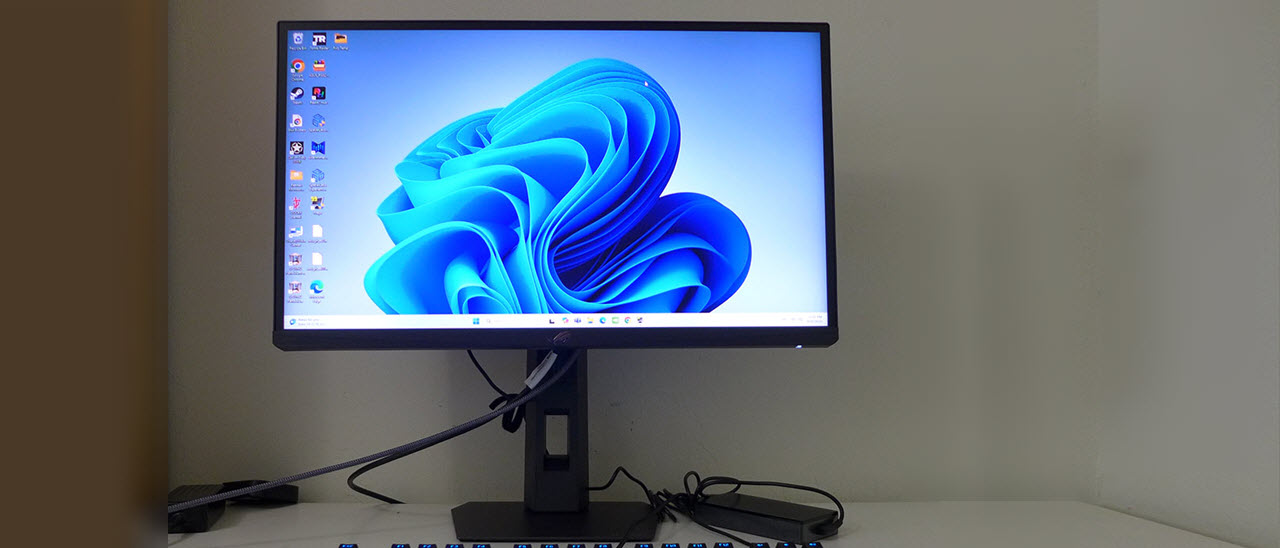Why you can trust Tom's Hardware
With so many fast OLEDs vying for buyers’ cash, the number of new LCDs running at 500 Hz or more has shrunk. I reached back in time to find screens from 280 to 500 Hz and included Asus’ 500 Hz OLED, the XG27AQDPG. The LCDs are Alienware’s AW2525HM and AW2542HF, ViewSonic’s XG2536, and BenQ’s XL2566X+.
Pixel Response and Input Lag
Click here to read up on our pixel response and input lag testing procedures.
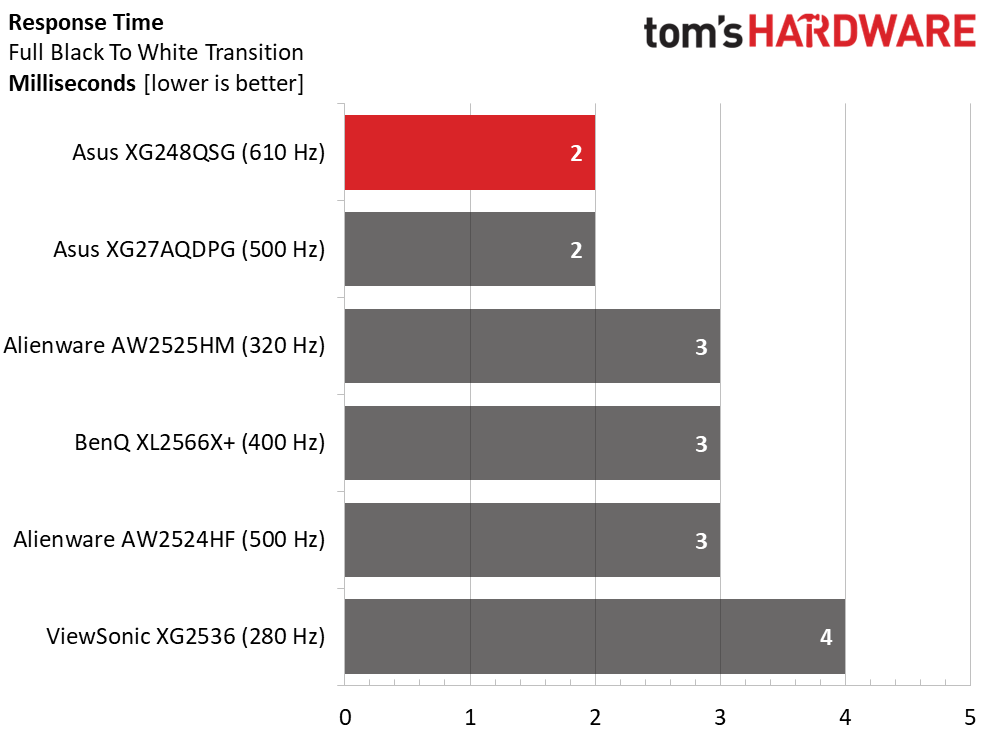
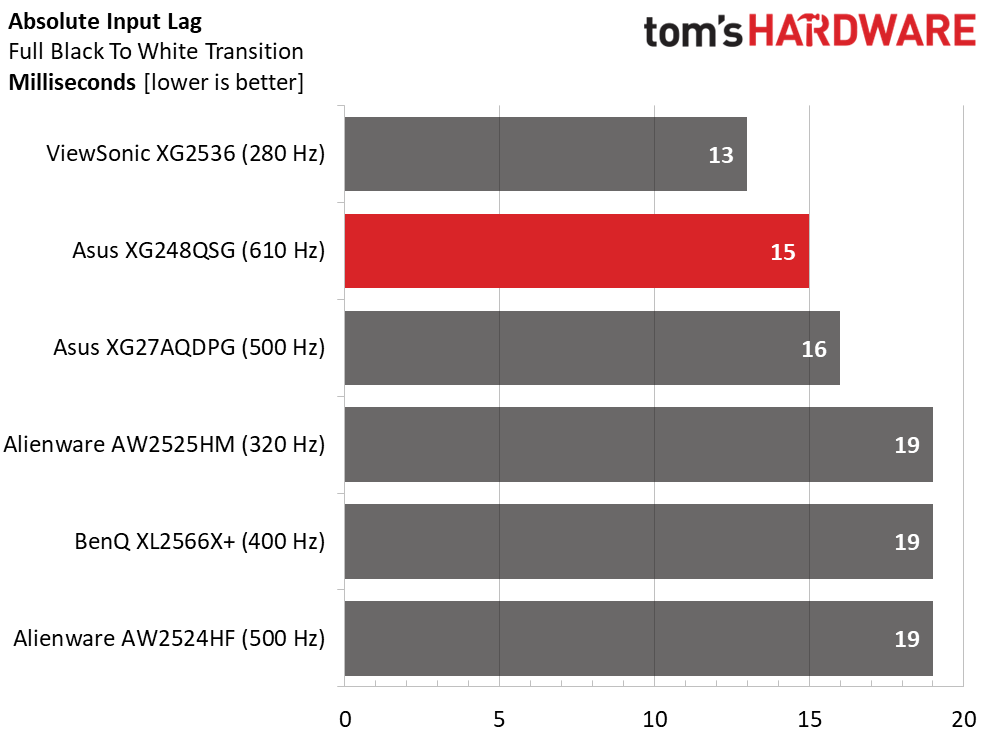
With the overclock engaged at 610 Hz, ELMB disabled, and Adaptive-Sync enabled, the XG248QSG matches the panel response of the 500 Hz XG27AQDPG. It might be a tad quicker, but I can’t measure less than one millisecond with my high-speed camera. Motion blur? It’s an LCD, so there is a tiny amount when the overdrive is turned off, but it’s only visible in test patterns. I set the overdrive to 7 out of 20 for artifact-free smoothness. ELMB is very effective at removing that last trace of blur and you have the option of ELMB Sync which lets you leave Adaptive-Sync on. ELMB 2 is the smoothest option of all. Even at its most aggressive setting, it only cuts brightness by around 40%.
Surprisingly, 610 Hz doesn’t mean record-breaking input lag. It’s certainly low at 15ms total, but the 280 Hz ViewSonic is a tad faster. And I’ve tested two OLEDs that ace this test in 10ms, the Philips 27M2N8500 and LG’s 27GX790A. This is a super tight race, though, with the slowest screens at 19ms of total lag.
Test Takeaway: In the quest for speed, you must consider both motion resolution and input lag. Anything under 20ms of total lag is essentially instant and most players can’t tell the difference between 19ms and 13ms. In the LCD realm though, you can’t have a frame rate that’s too fast. The XG248QSG couples that 610 Hz refresh with the best ELMB yet to achieve the smoothest moving image I’ve seen from an LCD. But remember, an OLED running at 240 Hz or faster also has perfect motion resolution. If you want the highest possible frame rate, the XG248QSG provides that. If you want the highest possible smoothness, nearly any fast OLED can provide that at a lower refresh rate.
Viewing Angles
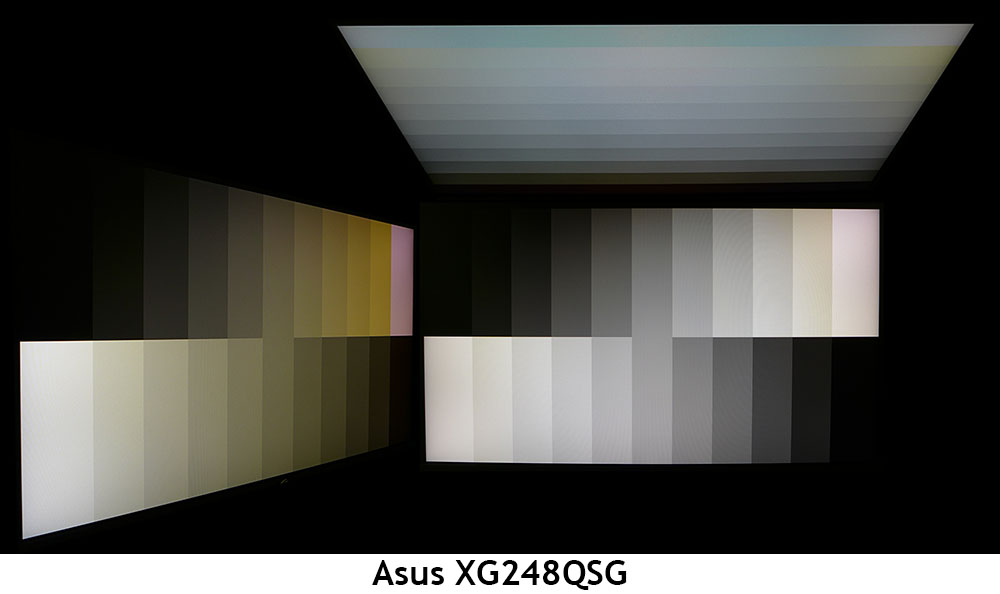
The XG248QSG is a TN panel, but its off-axis image quality isn’t too bad. You won’t mistake it for IPS, but the most obvious thing is the green shift. Brightness and gamma don’t change as much as typical TN monitors when viewed at 45 degrees to the side. The top view is washed out and dim with a blue shift.
Screen Uniformity
To learn how we measure screen uniformity, click here.
Get Tom's Hardware's best news and in-depth reviews, straight to your inbox.
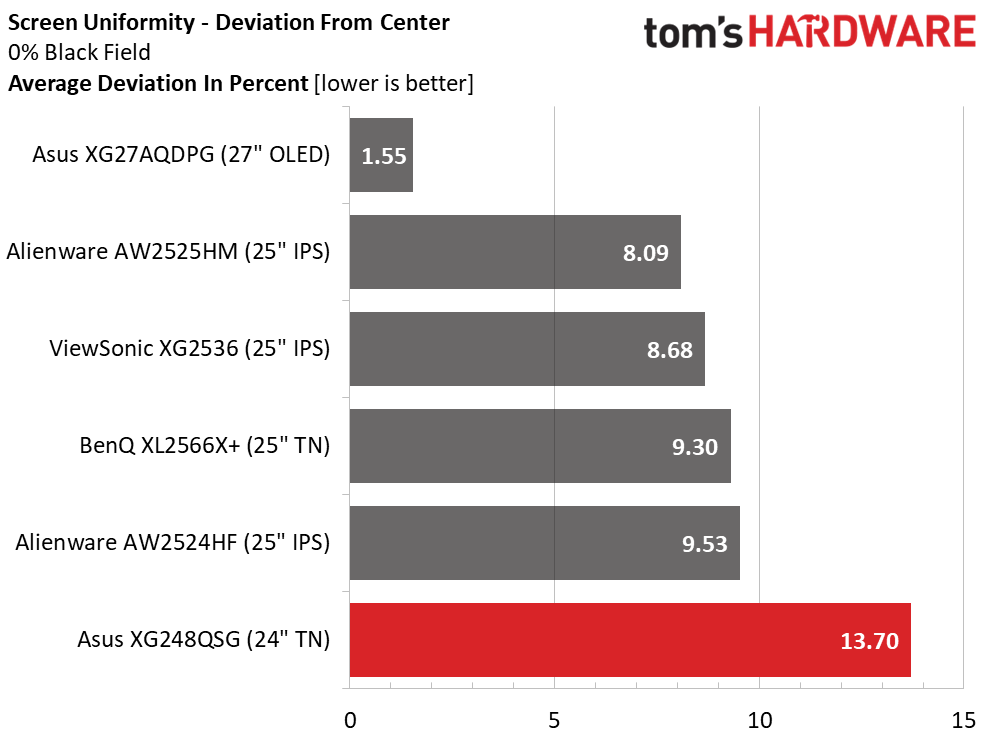
TN panels usually struggle with uniformity, and my XG248QSG sample posted a middling result. 13.7% means you can see the hot spots in a full black field pattern. My sample was mostly good except for a glow in the upper right corner. This didn’t impact content in any meaningful way.
MORE: Best Gaming Monitors
MORE: How We Test PC Monitors
MORE: How to Buy a PC Monitor
Current page: Response, Input Lag, Viewing Angles and Uniformity
Prev Page Features and Specifications Next Page Brightness and Contrast
Christian Eberle is a Contributing Editor for Tom's Hardware US. He's a veteran reviewer of A/V equipment, specializing in monitors. Christian began his obsession with tech when he built his first PC in 1991, a 286 running DOS 3.0 at a blazing 12MHz. In 2006, he undertook training from the Imaging Science Foundation in video calibration and testing and thus started a passion for precise imaging that persists to this day. He is also a professional musician with a degree from the New England Conservatory as a classical bassoonist which he used to good effect as a performer with the West Point Army Band from 1987 to 2013. He enjoys watching movies and listening to high-end audio in his custom-built home theater and can be seen riding trails near his home on a race-ready ICE VTX recumbent trike. Christian enjoys the endless summer in Florida where he lives with his wife and Chihuahua and plays with orchestras around the state.
-
Shiznizzle $1000 for a 1080p rectangle thing.Reply
Is it possible to tell the difference between 120 hz and 340 hz?
Possibly, but i doubt it.
How about from 340 to 610?
My answer is no.
If you say yes, then do a blind test and tell us which is which once there are enough 600 hz monitors on the market so you cant learn their color profiles and base your decision on that. Better yet. Do a black and white 600 hz test. Refresh rate is refresh rate so color should not matter. You clain to see the difference so tell us which one.
What do you mean you cant see the difference between 610 and 472? Are you blind?
We are now getting into the absurd levels of tech that not even humans can see the difference of. -
timsSOFTWARE Reply
You can certainly tell the difference between even 120 and 240 - ex. just move the mouse or a window around on the desktop. And because there is still motion blur even at 240, even reducing that by a further 2/3s with 700hz - there would still probably be room to reduce it further; maybe going to 2-3Khz before you'd be hard pressed to tell it was there.Shiznizzle said:$1000 for a 1080p rectangle thing.
Is it possible to tell the difference between 120 hz and 340 hz?
Possibly, but i doubt it.
How about from 340 to 610?
My answer is no.
If you say yes, then do a blind test and tell us which is which once there are enough 600 hz monitors on the market so you cant learn their color profiles and base your decision on that. Better yet. Do a black and white 600 hz test. Refresh rate is refresh rate so color should not matter. You clain to see the difference so tell us which one.
What do you mean you cant see the difference between 610 and 472? Are you blind?
We are now getting into the absurd levels of tech that not even humans can see the difference of.
But for professional gamers that buy these monitors, I think the bigger gain is actually in input lag from running at higher FPS, and being able to run the game effectively uncapped FPS wise without introducing screen tearing. -
Toomanyuserstaken So when you tested the input lag for this monitor, did you run the highest overdrive settings? Wouldn’t this improve the input lag scores even further? With asus claims of .8ms input latency you would assume this would be the fastest monitor ever created, but it isn’t even top 5!Reply -
Toomanyuserstaken Reply
Also, do you plan to test the asus pg27aqwp-w?Toomanyuserstaken said:So when you tested the input lag for this monitor, did you run the highest overdrive settings? Wouldn’t this improve the input lag scores even further? With asus claims of .8ms input latency you would assume this would be the fastest monitor ever created, but it isn’t even top 5!
I am almost positive this will be the fastest monitor when speaking about input lag. Especially with no DSC
